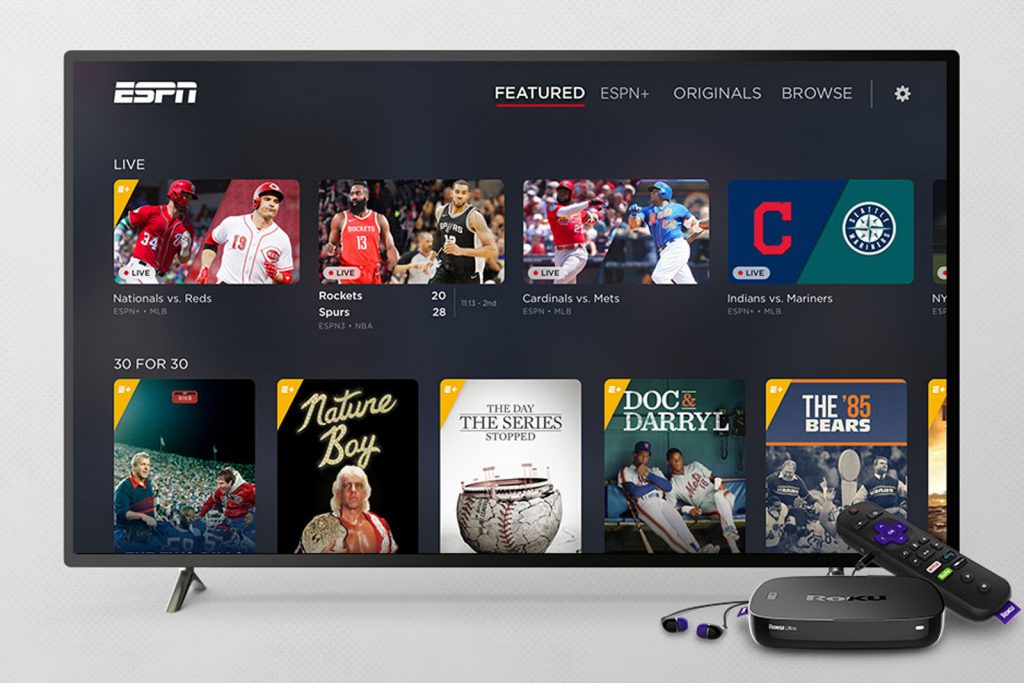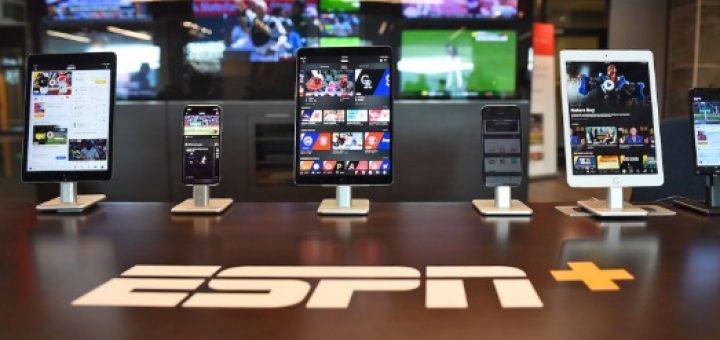Everything You Need to Know About ESPN+
Photo Credit: Melissa Rawlins / ESPN Images
I don’t consume media in the conventional way. I still watch a lot of cable television, which makes me a dinosaur. It also makes me something of a hypocrite, as a previous client of mine was a site called Cut Cable Today, something I never personally did. As someone who has evaluated cable television consumption professionally, I do have a vested interest in the medium, however, and that’s why I’m so fascinated by today’s topic. Here’s my review of ESPN+, one I’ve been working on for roughly two months!
The Basics
Let’s get the obvious stuff out of the way. ESPN+ is a new streaming service run by The Walt Disney Company. It exists because corporate executives understand that cable television is a dying medium, at least in its current form.


I should reduce the severity of that statement by noting that print media is also a dying medium, yet it will remain a part of society for at least another decade. AOL (!) still has more than 150 million users, for that matter. Saying that something is dying doesn’t mean it’s going to fade away anytime soon.
Keeping the reality of the situation in mind, the purpose of ESPN+ is maintain The Worldwide Leader’s position of dominance in sports broadcasting. Their target audience for this service is the under-35 crowd, the early adopters who appreciated the appeal of YouTube more than a decade ago and thereby weaned themselves off of traditional broadcast television in all forms.

With millions of customers cutting the cord, Disney’s going to lose that money…unless they can train the under-35 crowd to pay a different way. Let’s be honest that ESPN+ exists primarily for business purposes. My review will reflect this reality. The question is whether users receive enough from this service to justify the fee, which is currently $4.99 per month or $49.99 annually. Is it worth the money? Well…

My Setup
One of the ways that I’m a television dinosaur is that I still use, you know, a television. The statistics on cellphone media consumption are fairly staggering, as what once seemed like an indulgent way to watch a few shows has become the seminal form of viewing for many people, especially the under-18 crowd. They’ve grown up in a world where the second screen is their only screen, a place where they can watch their own programs instead of mom and dad’s boring grown-up stuff.
For the purposes of this review, I tried a bit of everything. My primary method was a Roku with the ESPN+ channel, but I also tested the service extensively on my iPad and iPhone. I understand that most of you will care the most about the smartphone aspect. I will say in advance that I recommend the Roku, as I prefer watching sports on a giant television, not a 5- or 10-inch screen. Like I said, I’m a fossil when it comes to media consumption. Keeping that in mind, here’s my overall user experience.


Photo Credit: Variety.com
Set Up
Signing up for ESPN+ is something of a mixed bag. I’m in the Apple ecosystem (yes, pity me), and so I had to download the ESPN app before I could do anything else. ESPN+ is a part of this app rather than a standalone. I find that sort of strange. I presume that Disney wants everyone to have a comfortable, familiar backdrop for the service.
I had no trouble adding ESPN+ to my account. Currently, the options are $4.99 per month ($59.88 annually) or a one-time annual payment of $49.99. Since an offer was available for a free month of service, I chose the monthly plan. This phase was simple.


Integrating ESPN+ into my existing ESPN account was something of a nightmare. I already had one that includes ESPN Insider. The system didn’t seem to like the combination of those two pay services on the same account. I’ll spare you the aggravating details, but I had to fight this for an hour. Later, my account reset, and I had to go through the process again. I mention this because I’m tech savvy. Someone who isn’t is likely to wash their hands of the situation and walk away. Hopefully, Disney improves the integration process.
Perhaps the most difficult part was adding the Roku to the ESPN+ account. This should have been simple, as the service lists a web address (es.pn/roku) and an activation code to link the account. Since my ESPN account wasn’t tied to my Apple account, the service I use to pay for ESPN+, I again had to fight to marry the two. I had to read several FAQs to find the information to activate ESPN+ on my Roku. Frankly, Disney needs to do a better job in this area.


I do want to add that people who plan to use their phones exclusively won’t have this problem. It happened because I’m so tethered to old media. I have a shiny HDR, 4K television for the purpose of watching sports. So, I need the Roku. If you don’t, you will go from buying ESPN+ to watching ESPN+ programming in two minutes or less. That part of the process is a breeze.
Picture and Streaming Quality
Once I finally had ESPN+ up and running, I was extremely impressed. One of the dirty secrets of cable television is that the picture quality on most systems is either 1080i or 720p. By now, most people are used to watching most of their media in AT LEAST 1080p. That picture quality is twice as good, and some services like Netflix even offer 2160p. Cable carriers don’t want to provide that sort of high-quality picture. It creates bandwidth issues and vastly increases operating expenses.


Photo Credit: Android Authority
I say all of this to note that streaming media isn’t the future; it’s the now and has been that way for a couple of years. People over a certain age simply didn’t notice. So, the ESPN picture quality that you would expect when you activate your cable box is actually INFERIOR to what you’ll see on ESPN+. Now, you might not be able to tell on a smartphone due to the picture size, but you will on a tablet. On a home television, you will be blown away by the crisp nature of the broadcast.
ESPN+ currently runs at 720p, which may cause you to wonder how it’s better than cable. The answer is that they’re running images at 60 frames per second rather than television’s conventional 30 frames per second. There’s less hiccupping as plays unfold, leading to a smoother picture. When you watch action sports like football, blurring is inevitable on standard cable television. On ESPN+, it’s a foreign concept.


Plus, the 720p picture quality is temporary. Disney will eventually upgrade to 1080p at 60 frames per second and eventually 2160p at that rate. Using a different streaming service for comparison, DirectTV Now has gone from 720p at 60 frames to second to 1080p in less than a year. They’re currently beta testing 2160p, which they’ve stated that they’ll roll out by the end of the year. Should ESPN+ follow that timeline, you’ll be watching sports at the highest possible quality by the end of 2019. In other words, it’s already better than what you’ve had in the past, and it will improve more at a later date.
For those of you who have streamed for several years, you likely remember the dark days of buffering. Smarter algorithms and codecs have negated this problem for the most part. Generally, when you have buffering issues these days, the problem is with your internet provider. Keeping that in mind, I stress-tested ESPN+ a lot. I never had a single buffering issue. It’s a non-factor.


The one other strange point I should make involves live sports. When you watch a game, you don’t want to get spoiled. Well, an oddity of ESPN+ is that you may be as much as two minutes behind live television at times. Generally, there’s a delay in the range of 20-45 seconds.
I used several baseball games to test this issue. I would play the same game via cable television on one television and ESPN+ on the Roku on the other one. Yes, I have two televisions in my living room. Don’t judge me!
While the picture was always better on ESPN+, the cable broadcast was ALWAYS ahead by just a bit. This is a non-factor most of the time. I simply want to bring the matter to your attention if there’s ever a situation wherein every second counts…say, for example, if you have loud neighbors who might cheer or boo when something happens. They would tip you about an upcoming play before you actually saw it. So, you’ve been warned.

Programming Quality
The true debate about ESPN+ is its necessity. This service isn’t quite in its infancy despite what Disney wants you to believe. The reality is that Disney has rebranded and augmented their ESPN 3 service. Many cable television owners have familiarity with this system, as it’s the place where ESPN broadcasts games that aren’t worthy of broadcasting on the main channels.
For our family, ESPN 3 has been terrific. My wife is an Illinois State University superfan living in Tennessee. Whenever the Redbirds played a big football or basketball game, she could watch it live on ESPN 3. ESPN+ is that same idea expanded to a logical extreme.


Much of the programming is niche. For example, I’ve watched rugby (which I don’t understand at all), Canadian Football League (which I somewhat understand), and some boxing (which is very easy to understand). I also learned that there is a Major League Rugby in the United States, and some sort of world event is going on right now, too. A soccer fan would love this service, because it has a seemingly endless supply of matches, but I’m the clichéd American who finds the sport boring.


What jumped out to me is that this service is still in its infancy. Disney is trying some things like Kobe Bryant’s breakdown of important NBA playoff games in a series called Detail. Since I always thought of Kobe Bryant as the worst teammate in major sports, I had little interest in this concept, but his cerebral insights on the X’s and O’s of NBA basketball pleasantly surprised me.
ESPN+ also opens up the vault on the storied 30 for 30 franchise. Fantastic features like The Two Bills (about Bill Belichick and Bill Parcells), Nature Boy (about Ric Flair), and The Fab 5 (about Michigan’s legendary team of five-star freshmen) almost single-handedly justify the purchase price of the service for some.

Disney has already opened up the wallet in anticipation of future expansion of ESPN+. They recently signed a huge agreement with UFC to broadcast fights 30 times per year. Presumably, all of these fights will go into the back catalog at ESPN+. And that’s the crux of their business model.

Overall Thoughts
The company wants to differentiate ESPN+ as the next generation of the Worldwide Leader. They want sports fans to know that they can use the service for a UFC main event, an afternoon baseball game, or an obscure cricket match. The service appeals to sports fanatics the most, but it has a secondary appeal for specialists.
For example, a fan of lacrosse or beach volleyball might not get to watch their sport live most of the time. As ESPN+ grows, it will become the de facto home for all of these events. At any given time, it might show a high school basketball game, a women’s college softball game, a gymnastics competition, a swim meet, an IndyCar race, a chess match, and an international curling competition. Every kind of sport is a potential broadcast event.


Once ESPN+ reaches maturity, it will become the monopolistic app for all major sports competitions. It’s clearly the future of ESPN…but is it something that you need right now? The answer is probably no unless you’re a diehard sports fan. That answer may change if you have a favorite sport that you want to watch live, though. ESPN+ is literally the only place to watch niche events.


For fans of Disney theme parks, the best way I can describe it is like this. Imagine if Disney started livestreaming every event that they host at ESPN Wide World of Sports. ESPN+ will grow into that, only it will broadcast competitions all around the world. That’s a pretty good deal for $4.99 a month.
Thanks for visiting MickeyBlog.com! For a FREE quote on your next Disney vacation, please fill out the form below!









